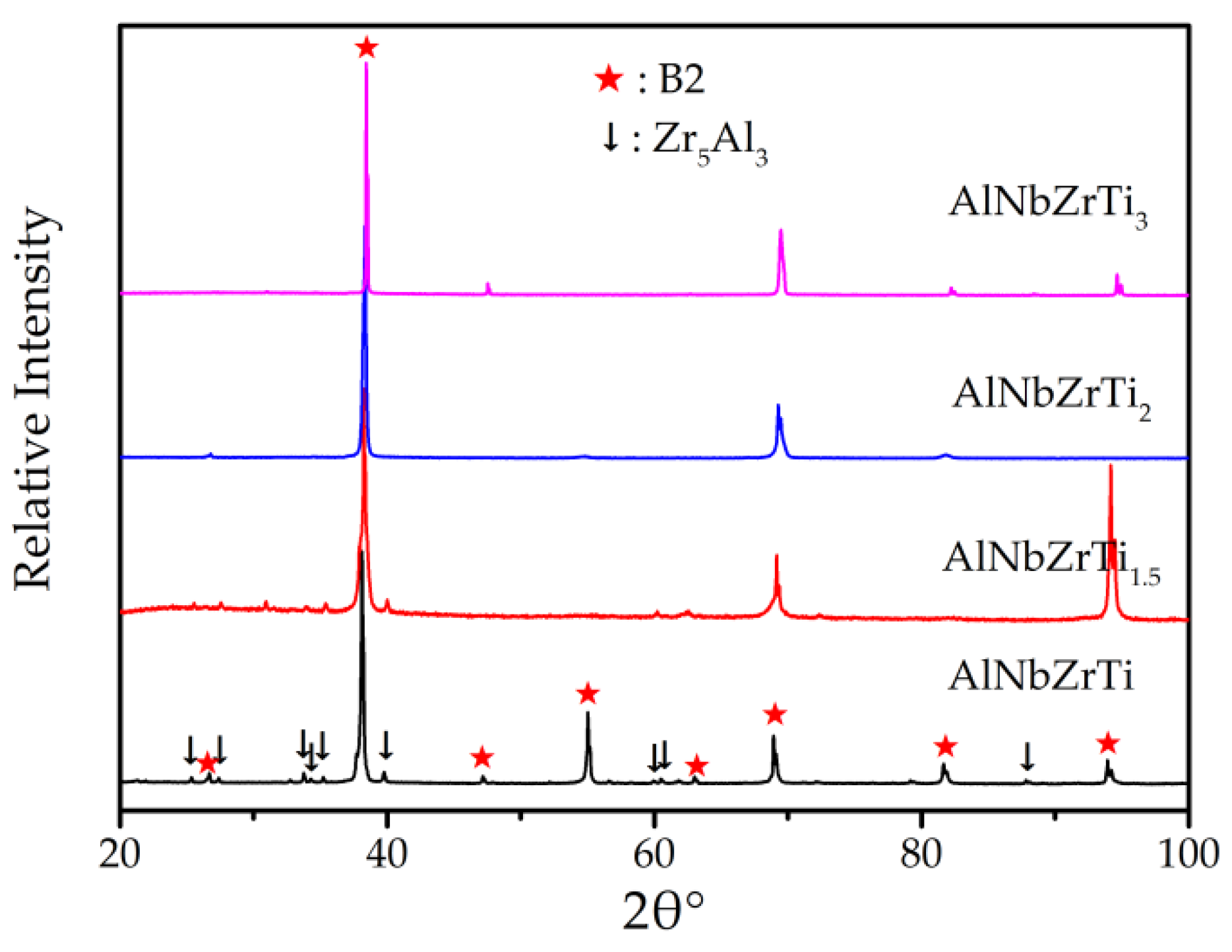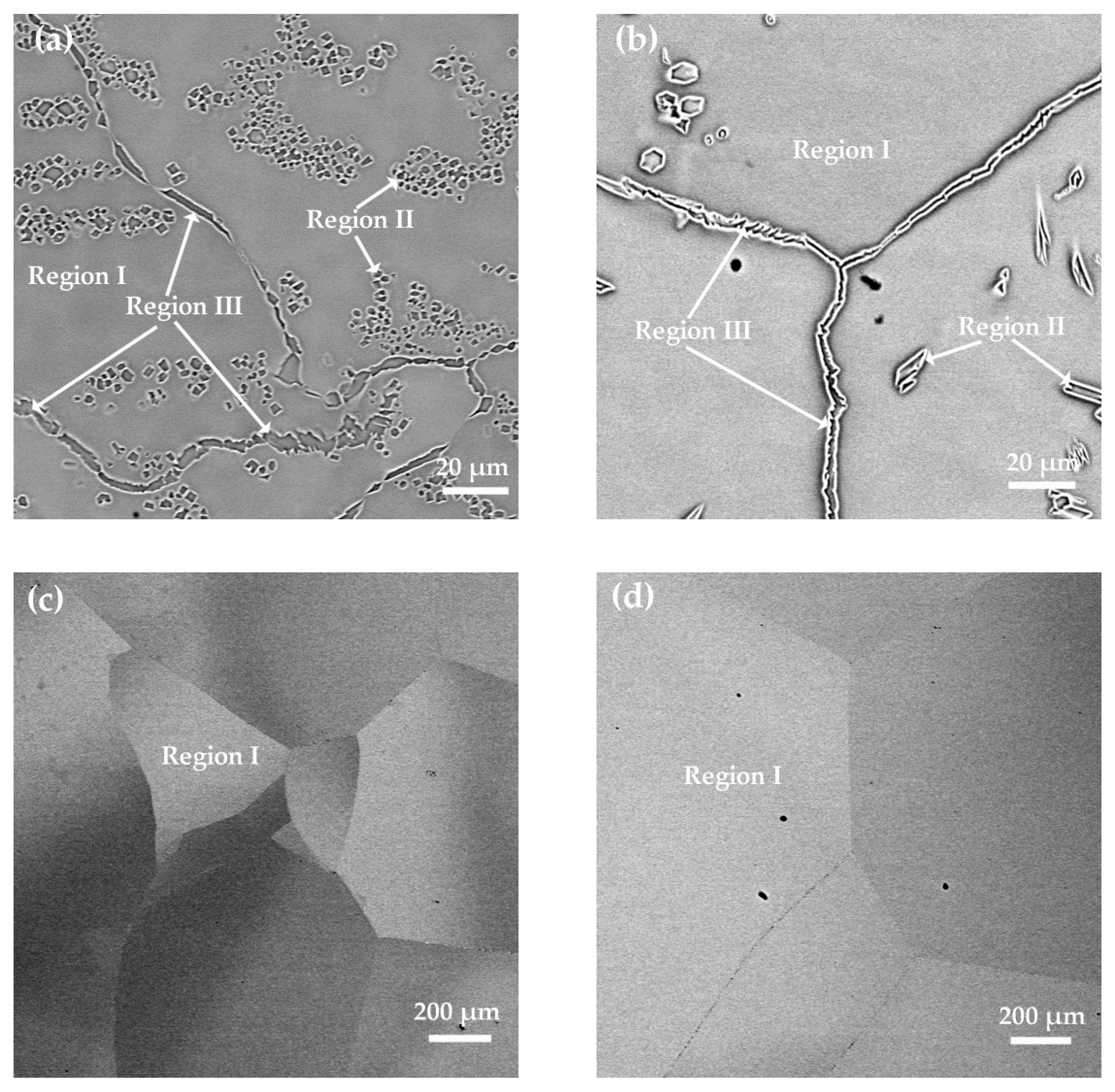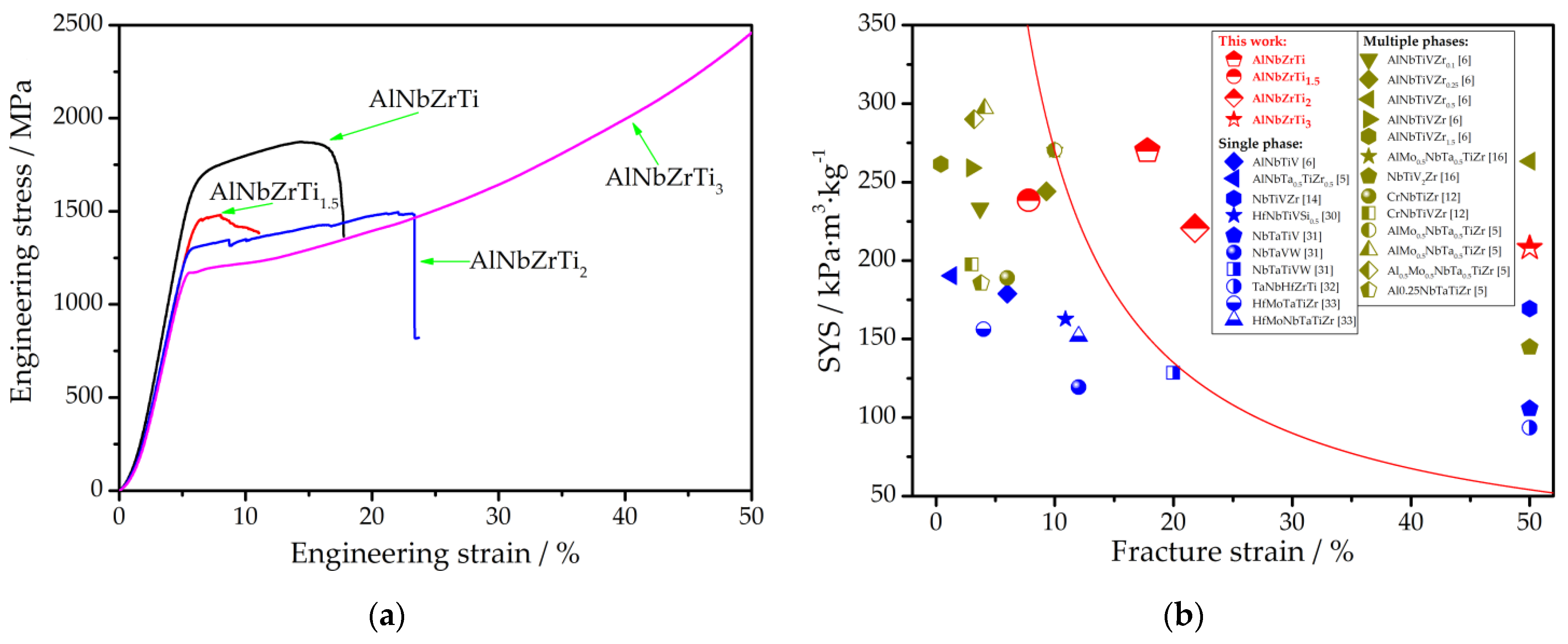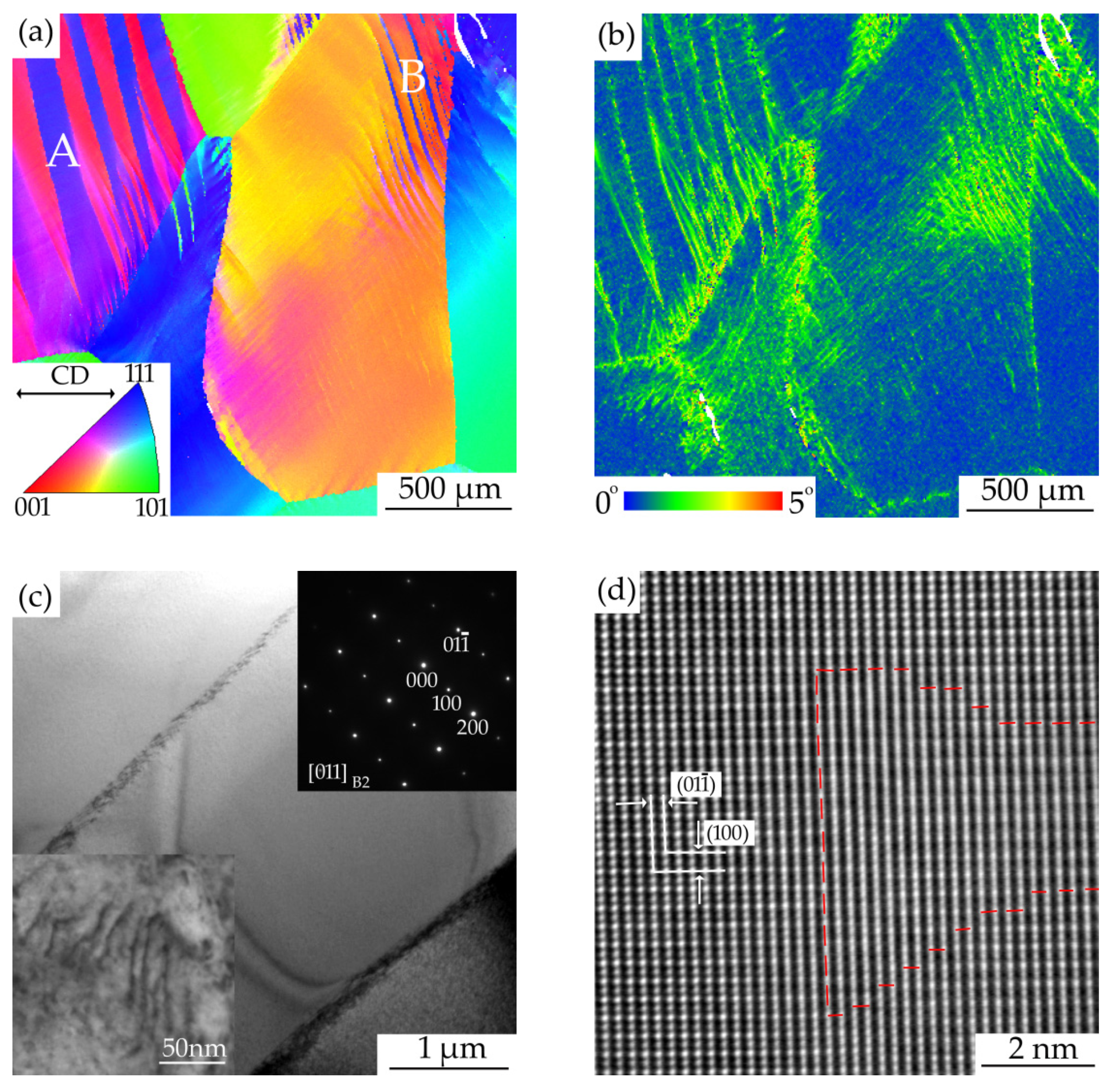Microstructure and Mechanical Properties of Low-Density, B2-Ordered AlNbZrTix Multi-Principal Element Alloys
Abstract
:1. Introduction
2. Materials and Methods
3. Results and Discussion
3.1. Phase Formation
3.2. Microstructural Characterization
3.3. Mechanical Property: Compressive Stress–Strain Analysis
4. Conclusions
- (1)
- As Ti content increases, the microstructure of the MPEAs transforms, from a mixture of B2 matrix and Zr5Al3-type phase (x = 1, 1.5) to a single-phase B2 structure (x = 2, 3). When x = 1, the Zr5Al3-type phase exhibits polygonal and rod-like shapes. When x = 1.5, the polygonal particles become irregular and the rod-like phase evolves into a continuous net along the B2 grain boundaries.
- (2)
- The Ti element in these alloys can stabilize a single-phase B2 structure, rather than a nanoscale BCC/B2 mixture, which can also be predicted by three previously-proposed parameters (Ω ≥ 1.1, δ ≤ 6.6%, and VEC < 6.87). These MPEAs exhibited a steady decrease in B2 lattice parameters, from ~0.3336 nm (x = 1) to ~0.3309 nm (x = 3), which is attributed to weaken lattice distortion caused by a reduced δ value.
- (3)
- The actual densities of the AlNbZrTix (x = 1, 1.5, 2, 3) MPEAs reduced by ~8.7%, from ~5.85 g·cm−3 (x = 1) to ~5.34 g·cm−3 (x = 3), and were lower than that of most reported MPEAs (≥6 g·cm−3). Thus, the specific yield strengths (SYS) of the AlNbZrTix (x = 1, 1.5, 2, 3) MPEAs were calculated to be ~270 kPa·m3·kg−1, ~238 kPa·m3·kg−1, ~221 kPa·m3·kg−1, >208 kPa·m3·kg−1, respectively.
- (4)
- The excellent fracture strain of AlNbZrTix (x = 1, 2, 3) alloys were ~17.8%, 21.8%, and >50%, respectively. This Ti-addition-induced ductility improvement was attributed to the reduced δ and gradual disappearance of the Zr5Al3-type phase. An exception was AlNbZrTi1.5 with a limited ductility of ~7.8%, which was explained through the distinct morphology and distribution of hard Zr5Al3-type phase.
- (5)
- The combined compressive properties (SYS and fracture strain) of AlNbZrTix (x = 1, 2, 3) were superior to the reported data of most BCC/B2-dominant MPEAs. The deformation mechanism of the B2 structure is closely related to a dislocation-based ductility mechanism, accompanied by antiphase domains. Our results provide an explanation for the high strength and exceptional room-temperature ductility of low-density B2 MPEAs.
Author Contributions
Funding
Data Availability Statement
Acknowledgments
Conflicts of Interest
Appendix A
| Abbreviations | Nomenclature | Definition |
| MPEA | Multi-principal element alloy | |
| FCC | Face-centered cubic | |
| BCC | Body-centered cubic | |
| HCP | Hexagonal-close-packed | |
| B2 | Ordered body-centered cubic | |
| SYS | Specific yield strength (strength-to-density ratio) | |
| XRD | X-ray diffraction | |
| TEM | Transmission electron microscopy | |
| STEM | Scanning transmission electron microscopy | |
| SEM | Scanning electron microscopy | |
| BSE | Backscatter electron | |
| EDS | Energy-dispersive spectrometer | |
| EBSD | Electron backscatter diffraction | |
| HAADF | High-angle annular dark-field | |
| FFT | Fourier transformation | |
| IPF | Inverse pole figure | |
| KAM | Kernel average misorientation | |
| SAED | Selected area electron diffraction | |
| ∆Gmix | Gibbs free energy | |
| ∆Hmix | Mixing enthalpy | |
| ∆Smix | Mixing entropy | |
| δ | Atomic misfit | |
| Ω | Multi-component solid solution rule | |
| VEC | Valence electron concentration | |
| Tm | Average calculated melting point | |
| Ti | Melting point of ith pure metal | |
| ci | Atomic fraction of the ith constituent | |
| cj | Atomic fraction of the jth constituent | |
| ith-jth-constituent mixing enthalpy | ||
| R | Gas constant | |
| ri | ith-constituent radius | |
| (VEC)i | Valence electron concentration of the ith constituent |
References
- Wang, Z.; Wu, H.; Wu, Y.; Huang, H.; Zhu, X.; Zhang, Y.; Zhu, H.; Yuan, X.; Chen, Q.; Wang, S. Solving oxygen embrittlement of refractory high-entropy alloy via grain boundary engineering. Mater. Today 2022, 54, 83–89. [Google Scholar] [CrossRef]
- Lei, Z.; Liu, X.; Wu, Y.; Wang, H.; Jiang, S.; Wang, S.; Hui, X.; Wu, Y.; Gault, B.; Kontis, P.; et al. Enhanced strength and ductility in a high-entropy alloy via ordered oxygen complexes. Nature 2018, 563, 546–550. [Google Scholar] [CrossRef]
- Liu, F.; Liaw, P.K.; Zhang, Y. Recent Progress with BCC-Structured High-Entropy Alloys. Metals 2022, 12, 501. [Google Scholar] [CrossRef]
- Gludovatz, B.; Hohenwarter, A.; Catoor, D.; Chang, E.H.; George, E.P.; Ritchie, R.O. A fracture-resistant high-entropy alloy for cryogenic applications. Science 2014, 345, 1153–1158. [Google Scholar] [CrossRef] [Green Version]
- Senkov, O.N.; Jensen, J.K.; Pilchak, A.L.; Miracle, D.B.; Fraser, H.L. Compositional variation effects on the microstructure and properties of a refractory high-entropy superalloy AlMo0.5NbTa0.5TiZr. Mater. Des. 2017, 139, 498–511. [Google Scholar] [CrossRef]
- Yurchenko, N.Y.; Stepanov, N.D.; Zherebtsov, S.V.; Tikhonovsky, M.A.; Salishchev, G.A. Structure and mechanical properties of B2 ordered refractory AlNbTiVZrx (x = 0–1.5) high-entropy alloys. Mater. Sci. Eng. A 2017, 704, 82–90. [Google Scholar] [CrossRef] [Green Version]
- Ter-Isahakyan, A.; Rau, J.S.; Balk, T.J. High entropy alloys with hexagonal close-packed structure derived from thin film combinatorial approach. J. Alloys Compd. 2021, 893, 162293. [Google Scholar] [CrossRef]
- Miracle, D.B.; Senkov, O.N. A critical review of high entropy alloys and related concepts. Acta Mater. 2017, 122, 448–511. [Google Scholar] [CrossRef] [Green Version]
- Zýka, J.; Málek, J.; Veselý, J.; Lukáč, F.; Čížek, J.; Kuriplach, J.; Melikhova, O. Microstructure and Room Temperature Mechanical Properties of Different 3 and 4 Element Medium Entropy Alloys from HfNbTaTiZr System. Entropy 2019, 21, 114. [Google Scholar] [CrossRef] [Green Version]
- Li, Y.; Liaw, P.K.; Zhang, Y. Microstructures and Properties of the Low-Density Al15Zr40Ti28Nb12M(Cr, Mo, Si)5 High-Entropy Alloys. Metals 2022, 12, 496. [Google Scholar] [CrossRef]
- Youssef, K.M.; Zaddach, A.J.; Niu, C.; Irving, D.L.; Koch, C.C. A Novel Low-Density, High-Hardness, High-entropy Alloy with Close-packed Single-phase Nanocrystalline Structures. Mater. Res. Lett. 2014, 3, 95–99. [Google Scholar] [CrossRef] [Green Version]
- Senkov, O.N.; Senkova, S.V.; Woodward, C.; Miracle, D.B. Low-density, refractory multi-principal element alloys of the Cr-Nb-Ti-V-Zr system: Microstructure and phase analysis. Acta Mater. 2013, 61, 1545–1557. [Google Scholar] [CrossRef]
- Qiu, Y.; Hu, Y.J.; Taylor, A.; Styles, M.J.; Marceau, R.K.W.; Ceguerra, A.V.; Gibson, M.A.; Liu, Z.K.; Fraser, H.L.; Birbilis, N. A lightweight single-phase AlTiVCr compositionally complex alloy. Acta Mater. 2017, 123, 115–124. [Google Scholar] [CrossRef] [Green Version]
- Senkov, O.N.; Senkova, S.V.; Miracle, D.B.; Woodward, C. Mechanical properties of low-density, refractory multi-principal element alloys of the Cr-Nb-Ti-V-Zr system. Mater. Sci. Eng. A 2013, 565, 51–62. [Google Scholar] [CrossRef]
- Kumar, A.; Gupta, M. An Insight into Evolution of Light Weight High Entropy Alloys: A Review. Metals 2016, 6, 199. [Google Scholar] [CrossRef] [Green Version]
- Senkov, O.N.; Senkova, S.V.; Woodward, C. Effect of aluminum on the microstructure and properties of two refractory high-entropy alloys. Acta Mater. 2014, 68, 214–228. [Google Scholar] [CrossRef]
- Chen, W.; Tang, Q.H.; Wang, H.; Xie, Y.C.; Yan, X.H.; Dai, P.Q. Microstructure and mechanical properties of a novel refractory AlNbTiZr high-entropy alloy. Mater. Sci. Technol. 2018, 34, 1309–1315. [Google Scholar] [CrossRef]
- Chen, Y.; Liu, W.; Wang, H.; Xie, J.; Zhang, T.; Yin, L.; Huang, Y. Effect of Ti Content on the Microstructure and Properties of CoCrFeNiMnTix High Entropy Alloy. Entropy 2022, 24, 241. [Google Scholar] [CrossRef]
- Qiu, X.W.; Zhang, Y.P.; Liu, C.G. Effect of Ti content on structure and properties of Al2CrFeNiCoCuTix high-entropy alloy coatings. J. Alloys Compd. 2014, 585, 282–286. [Google Scholar] [CrossRef]
- Hwl, A.; Yang, S.A.; Jfl, B.; Wlm, A.; Zdh, A.; Cs, C.; Kfy, A. Phase stabilities of high entropy alloys. Scr. Mater. 2020, 179, 40–44. [Google Scholar]
- Zhang, Y.; Zhou, Y.J.; Lin, J.P.; Chen, G.L.; Liaw, P.K. Solid-Solution Phase Formation Rules for Multi-component Alloys. Adv. Eng. Mater. 2008, 10, 534–538. [Google Scholar] [CrossRef]
- Yang, X.; Chen, S.Y.; Cotton, J.D.; Zhang, Y. Phase Stability of Low-Density, Multiprincipal Component Alloys Containing Aluminum, Magnesium, and Lithium. JOM 2014, 66, 2009–2020. [Google Scholar] [CrossRef]
- Yang, X.; Zhang, Y. Prediction of high-entropy stabilized solid-solution in multi-component alloys. Mater. Chem. Phys. 2012, 132, 233–238. [Google Scholar] [CrossRef]
- Zhang, Y.; Yang, X.; Liaw, P.K. Alloy Design and Properties Optimization of High-Entropy Alloys. JOM 2012, 64, 830–838. [Google Scholar] [CrossRef]
- Guo, S.; Ng, C.; Lu, J.; Liu, C.T. Effect of valence electron concentration on stability of fcc or bcc phase in high entropy alloys. J. Appl. Phys. 2011, 109, 103505. [Google Scholar] [CrossRef] [Green Version]
- Takeuchi, A.; Inoue, A. Mixing enthalpy of liquid phase calculated by miedema’s scheme and approximated with sub-regular solution model for assessing forming ability of amorphous and glassy alloys. Intermetallics 2010, 18, 1779–1789. [Google Scholar] [CrossRef]
- Kazantseva, N.V.; Sazonova, V.A.; Lyzhina, G.A. Effect of the annealing temperature on the long-range order in the B2 phase of the Ti-Al-Nb(Zr, Mo) alloy. Phys. Met. Metallogr. 2006, 102, 288–294. [Google Scholar] [CrossRef]
- Tao, W.; Jin, Z.; Zhao, J.C. Thermodynamic assessment of the Al-Zr binary system. J. Phase Equilib. Diff. 2001, 22, 544–551. [Google Scholar]
- Soni, V.; Senkov, O.N.; Gwalani, B.; Miracle, D.B.; Banerjee, R. Microstructural Design for Improving Ductility of An Initially Brittle Refractory High Entropy Alloy. Sci. Rep. 2018, 8, 8816. [Google Scholar] [CrossRef] [Green Version]
- Zhang, Y.; Liu, Y.; Li, Y.; Chen, X.; Zhang, H. Microstructure and mechanical properties of a refractory HfNbTiVSi0.5 high-entropy alloy composite. Mater. Lett. 2016, 174, 82–85. [Google Scholar] [CrossRef]
- Yao, H.W.; Qiao, J.W.; Gao, M.C.; Hawk, J.A.; Ma, S.G.; Zhou, H.F.; Zhang, Y. NbTaV-(Ti,W) refractory high-entropy alloys: Experiments and modeling. Mater. Sci. Eng. A 2016, 674, 203–211. [Google Scholar] [CrossRef]
- Senkov, O.N.; Senkova, S.V.; Meisenkothen, F.; Miracle, D.B.; Woodward, C.F. Microstructure and elevated temperature properties of a refractory TaNbHfZrTi alloy. J. Mater. Sci. 2012, 47, 4062–4074. [Google Scholar] [CrossRef]
- Juan, C.C.; Tsai, M.H.; Tsai, C.W.; Lin, C.M.; Wang, W.R.; Yang, C.C.; Chen, S.K.; Lin, S.J.; Yeh, J.W. Enhanced mechanical properties of HfMoTaTiZr and HfMoNbTaTiZr refractory high-entropy alloys. Intermetallics 2015, 62, 76–83. [Google Scholar] [CrossRef]
- Yamaguchi, M.; Umakoshi, Y. The deformation behaviour of intermetallic superlattice compounds. Prog. Mater. Sci. 1990, 34, 1–148. [Google Scholar] [CrossRef]
- Goo, E.; Duerig, T.; Melton, K.; Sinclair, R. Mechanical twinning in Ti50Ni47Fe3 and Ti49Ni51 alloys. Acta Metall. 1985, 33, 1725–1733. [Google Scholar] [CrossRef]
- Dirras, G.; Lilensten, L.; Djemia, P.; Laurent-Brocq, M.; Tingaud, D.; Couzinié, J.P.; Perrière, L.; Chauveau, T.; Guillot, I. Elastic and plastic properties of as-cast equimolar TiHfZrTaNb high-entropy alloy. Mater. Sci. Eng. A 2016, 654, 30–38. [Google Scholar] [CrossRef]
- Feuerbacher, M. Dislocations and deformation microstructure in a B2-ordered Al28Co20Cr11Fe15Ni26 high-entropy alloy. Sci. Rep. 2016, 6, 29700. [Google Scholar] [CrossRef] [Green Version]





| Al | Nb | Zr | Ti | |
|---|---|---|---|---|
| Al | - | −18.2 | −43.7 | −29.5 |
| Nb | - | - | 3.9 | 2 |
| Zr | - | - | - | −0.2 |
| Ti | - | - | - | - |
| Alloys | Tm (K) | ∆Hmix (kJ·mol−1) | ∆Smix (J·K−1·mol−1) | δ (%) | Ω | VEC |
|---|---|---|---|---|---|---|
| AlNbZrTi | 1935.74 | −21.4250 | 11.53 | 3.85 | 1.04 | 4 |
| AlNbZrTi1.5 | 1936.56 | −19.6642 | 11.38 | 3.70 | 1.12 | 4 |
| AlNbZrTi2 | 1937.22 | −18.1440 | 11.08 | 3.57 | 1.18 | 4 |
| AlNbZrTi3 | 1938.21 | −15.6778 | 10.33 | 3.34 | 1.28 | 4 |
| Alloys | Region | Chemical Compositions (at.%) | |||
|---|---|---|---|---|---|
| Al | Nb | Zr | Ti | ||
| AlNbZrTi | Nominal | 25 | 25 | 25 | 25 |
| I | 23.1 | 24.7 | 25.2 | 27 | |
| II | 34.2 | 12.9 | 41.1 | 11.8 | |
| III | 35.1 | 12.8 | 41.2 | 10.9 | |
| AlNbZrTi1.5 | Nominal | 22.2 | 22.2 | 22.2 | 33.4 |
| I | 21.9 | 21.5 | 22.7 | 33.9 | |
| II | 33.5 | 12.9 | 38.3 | 15.3 | |
| III | 28.7 | 12.9 | 40.9 | 17.5 | |
| AlNbZrTi2 | Nominal | 20 | 20 | 20 | 40 |
| I | 19.9 | 19.3 | 20.5 | 40.3 | |
| AlNbZrTi3 | Nominal | 16.7 | 16.7 | 16.7 | 49.9 |
| I | 16.3 | 17.0 | 16.9 | 49.8 | |
| Alloys | Actual Density (g·cm−3) | Yield Strength (MPa) | Fracture Strain (%) | Strength-to-Density Ratio (SYS, kPa·m3·kg−1) |
|---|---|---|---|---|
| AlNbTiZr | 5.85 | 1579 | 17.8 | 270 |
| AlNbTiZr1.5 | 5.72 | 1364 | 7.8 | 238 |
| AlNbTiZr2 | 5.56 | 1227 | 21.8 | 221 |
| AlNbTiZr3 | 5.34 | 1111 | >50 | >208 |
Publisher’s Note: MDPI stays neutral with regard to jurisdictional claims in published maps and institutional affiliations. |
© 2022 by the authors. Licensee MDPI, Basel, Switzerland. This article is an open access article distributed under the terms and conditions of the Creative Commons Attribution (CC BY) license (https://creativecommons.org/licenses/by/4.0/).
Share and Cite
Tang, Q.; Su, H.; Peng, S.; Chen, W.; Dai, P. Microstructure and Mechanical Properties of Low-Density, B2-Ordered AlNbZrTix Multi-Principal Element Alloys. Metals 2022, 12, 932. https://doi.org/10.3390/met12060932
Tang Q, Su H, Peng S, Chen W, Dai P. Microstructure and Mechanical Properties of Low-Density, B2-Ordered AlNbZrTix Multi-Principal Element Alloys. Metals. 2022; 12(6):932. https://doi.org/10.3390/met12060932
Chicago/Turabian StyleTang, Qunhua, Honghong Su, Shilong Peng, Wei Chen, and Pinqiang Dai. 2022. "Microstructure and Mechanical Properties of Low-Density, B2-Ordered AlNbZrTix Multi-Principal Element Alloys" Metals 12, no. 6: 932. https://doi.org/10.3390/met12060932





